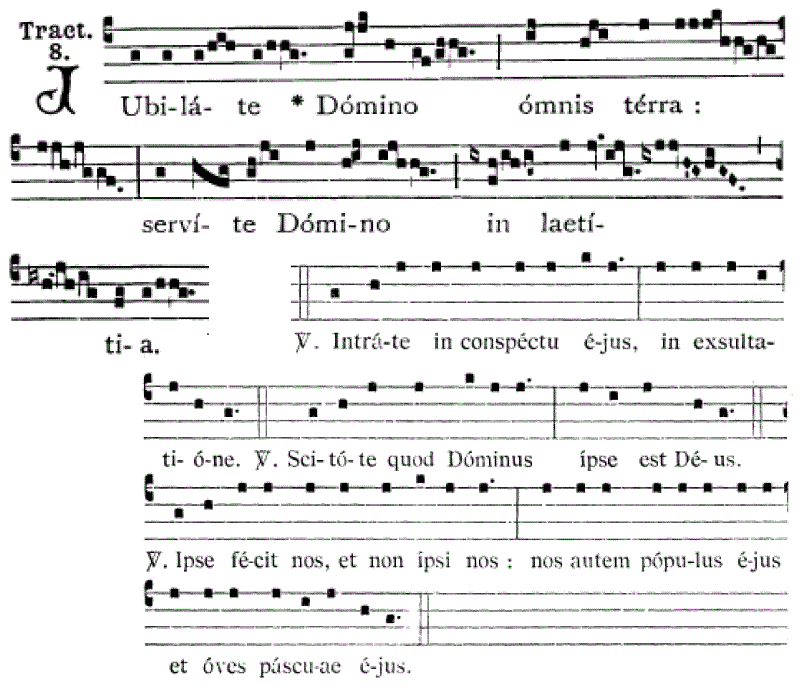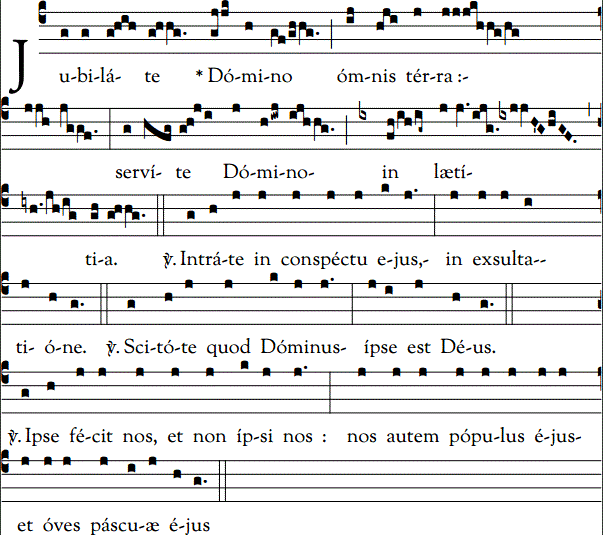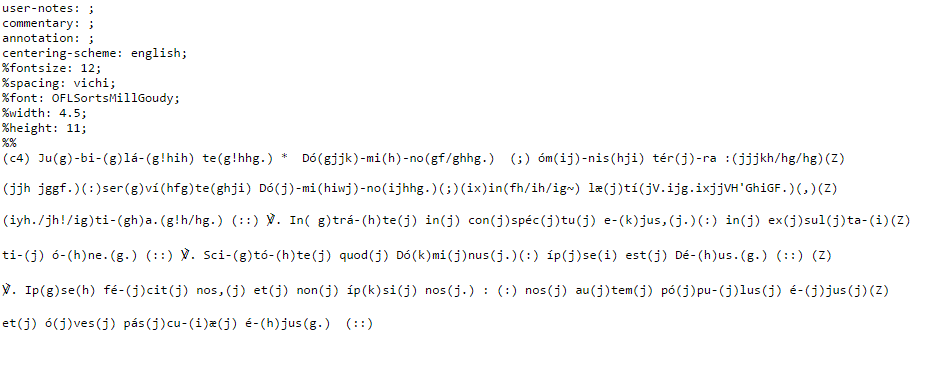Gregorio--Gregorian notation software
-
I've been learning how to write "gabc" notation code, and reading about Gregorio . Does anyone here use it? Is it any good? Are there better Gregorian notation programs? (I need one that will work on Linux.)
-
Lots of people here use it, it is the best tool available.
If you are on Linux, you are probably familiar with LaTeX. Gregorio works in conjuction with LaTeX.
Getting it installed and having all the pieces work together properly is a hassle, but it's definitely the way to go. -
Also, you should learn gabc first and use something like this to render it, unless you are already very, very comfortable with LaTeX or generally more technically minded.
-
Adam Wood wrote:
.Lots of people here use it, it is the best tool available
Great, then lots of people here must have installed it, and maybe some of them will hear my cries for help if I have a problem. :o)If you are on Linux, you are probably familiar with LaTeX. Gregorio works in conjuction with LaTeX.
I've used nothing but Linux on my home computers since 1999, and yet I've always successfully avoided LaTex until now. Maybe no longer, I guess.Getting it installed and having all the pieces work together properly is a hassle, but it's definitely the way to go.
Is there any kind of guide to getting it installed and having all the pieces work together properly? -
Ben Yanke wrote:Also, you should learn gabc first and use something like this to render it, unless you are already very, very comfortable with LaTeX or generally more technically minded.
I'm already learning gabc. I just wrote some simplified propers for the Feast of All Saints in gabc. It would be nice to see how they really look. Come to think of it . . . while I'm waiting to see how to get all the pieces for Gregorio installed, maybe somebody could run it through their already-installed program and see if it works. (If it doesn't, I'm probably not ready for LaTex yet!) Here it is:name: Feast of All Saints--Introit;
%%
(c4) Gau(c)de(d)a(dh'ix)mus(h.) *(,) o(h)mnes(g) in(f) Do(gh)mi(h)no(hjh.g.) (;) di(f)em(gh) fe(h)stum(h) ce(hj)le(h)bran(hg~)tes(g.h.) (,) sub(h) ho(h)no(h)re(h) Sanc(h)to(g)rum(f) om(gh)ni(g)um(gFED.)
de(f) quo(gh)rum(h) so(h)lem(h)ni(h)ta(h)te(h) gau(hj)dent(h) An(h)ge(hg)li,(g.h.) (;) et(gf) col(gh)lau(h)dant(h) Fi(h)li(g)um(f) De(gh)i.(gFED.)
Ps.(::)Ex(f)sul(gh)ta(h)te(h) ju(hj)sti(h) in(h) Do(h)mi(hg)no(g.h.) :(:) rec(gf)tos(gh) de(h)cet(h) col(hjh)lau(g)da(f)ti(fff)o.(d.) (::)
Glo(f)ri(gh)a(h) Pa(h)tri(h) et(h) Fi(h)li(h)o(h) (,) et(h) Spi(h)ri(hj)tu(h)i(h) Sanc(hg)to(g.h.) :(:) si(gf)cut(gh) e(h)rat(h) in(h) prin(h)ci(h)pi(h)o(h) et(h) nunc(hj) et(h) sem(hg)per(g.h.) (,) et(gf) in(gh) sae(h)cu(h)la(h) sae(h)cu(hjh)lo(g)rum.(f) A(fff)men.(d.)
name: Feast of All Saints--Gradual and Alleluia;
%%
(c4) Ti(d_c)me(d)te(fg) Do(h)mi(h)num(h) om(h)nes(h) san(ix)cti(h) e(g)jus(h.) :(:) quo(h)ni(h)am(h) ni(h)hil(h) de(h)est(h) ti(h)men(h)ti(g)bus(f) e(gh)um.(gFED.)
V/.(::) In(d'fddc~)qui(f)ren(gh)tes(h) au(ix)tem(h) Do(g)mi(h)num(h.) (:) non(h) de(h)fi(h)ci(h)ent(h) om(g)ni(f) bo(gh)no.(gFED.) (:)
(c3)Al(eed~)le(ff)lu(hiHffe~)ia.(e.) *ij.(;) a(defgwhihjijvHF.) (,) a(e_h_f_eFEDeefehhe.) V/.(::) Ve(e)ni(f)te(h) ad(h) me,(h.) o(h)mnes(h) qui(h) la(h)bo(h)ra(h.)tis,(f.) (,) et(h) o(h)ne(h)ra(h)ti(h) e(i)stis(h.) :(:) et(h) e(h)go(h) re(h)fi(g)ci(h)am(f) vos.(e.) (::)
name: Feast of All Saints--Offertory;
%%
(c4)Ju(d)sto(ffghgh)rum(fgf.) *(,) a(f)ni(gh)mae(h) in(h) ma(ix)nu(h) De(g)i(h) sunt,(h) (:) et(h) non(h) tan(h)get(h) il(h)los(h) tor(h)men(h)tum(g) ma(f)li(gh)ti(g)ae(gFED.) :(:)
vi(cd)si(d) sunt(f) o(gh)cu(h)lis(h) in(h)si(h)pi(h)en(ix)ti(h)um(h) mo(g)ri(h.) :(:) il(h)li(h) au(h)tem(h) sunt(g) in(f) pa(gh)ce,(gFED.) (:) al(cd)le(f_g_f_hGFED)lu(cd~)ia.(d.) (::)
name: Feast of All Saints--Communion;
%%
(c4)Be(h)a(h)ti(hvg) mun(hj)do(ji)cor(hi)de,(h.) *(;) quo(h)ni(g)am(f) i(gh)psi(h.) (,) De(h)um(g) vi(f)de(gh)bunt(gFED.) :(:)
be(df)a(gh)ti(g) pa(f)ci(gh)fi(h)ci(h.) (;) quo(h)ni(g)am(f) fi(gh)li(h)i(h) De(j)i(h) vo(g)ca(f)bun(gh)tur(gFED.) :(:)
be(fhj)a(jkl)ti(k_j) (,) qui(j) per(j)se(h)cu(g)ti(f)o(gh)nem(h) pa(j)ti(h)un(g)tur(h.) pro(h)pter(g) ju(f)sti(gh)ti(h)am,(h.) (:) quo(h)ni(g)am(f) ip(g)so(gh)rum(h) est(h) re(h)gnum(g) cae(f)lo(gh)rum.(gFED.) (::) -
Thanked by 1Adam Wood
-
An information site on Gregorio, with links to other resources, is:
http://gregoriochant.org/
One of those resources is GregoBase, a collection of gabc files, including all the Mass propers.
The official Gregorio web site, with installation instructions, is at
http://home.gna.org/gregorio/
Installation procedures vary depending on your Linux distribution. The web site procedure is for Debian. Join the gregorio-users mailing list to get advice and problem-solving help.
You can test your gabc at my Gregorio web interface, at http://gregorio.gabrielmass.com/ .
-
That's the first link I gave. :)You can test your gabc at my Gregorio web interface, at http://gregorio.gabrielmass.com/ . -
That has happened to me, too, Richard. At least we double covered it!! :)
-
chonak wrote:You can test your gabc at my Gregorio web interface, at http://gregorio.gabrielmass.com/ .
Great--it works! After correcting several errors, I came up with the attached PDF (All Saints Introit, simplified). I'll try some more and (no doubt) correct some more errors; then I'll probably be back with some questions about fitting things on pages, etc. Thanks!!
 allsaints_introit.pdf22KThanked by 1CHGiffen
allsaints_introit.pdf22KThanked by 1CHGiffen -
OK, I've got simplified versions of the Gradual/Alleluia, Offertory, and Communion done, with errors corrected. Next step: fitting them all together compactly. Is there a way to put them all in one PDF, with an initial for each one and a little annotation like "Intr.," "Grad.," etc., above the initial?
-
For an annotation, add a header line such as (e.g.):
annotation: Intr.;
To combine multiple scores, you can convert each PDF to an image file (PNG, JPEG, etc.) using GIMP (which you have on your Linux machine), crop the images to size, and then use a word processor like OpenOffice Writer to combine them.
-
I was figuring it might be something like that. The drawback is that I think the image files are a lot bigger than the PDFs, but I guess it can't be helped. Actually I didn't need the word processor; I just imported the PDFs into GIMP, cropped, cut, pasted, saved, and printed. If only my wife were not begging me to come to dinner at this moment, I'd post the result. Thanks again!
-
Is there a way to add a copyright footer using the interface? (I'm afraid I've guessed the answer already, but hope springs...)
-
The web interface is for a simple case: one score with just the headers you've seen; it doesn't offer any footer option.
Thanked by 1Richard Mix -
So, I just tried to self-learn this program for the sake of cleaning up my cut+paste Tract for Quinquagesima.

Here's what I came up with:
This is what I typed into the program: (I don't know what the top text is for..?)
Is there anything I should have done differently to make this look any better?
 gregorio.gif605 x 539 - 32K
gregorio.gif605 x 539 - 32K -
- set centering scheme to latin
It would look better, and be more readable if you
- drop the line breaks (Z)
OR
- do something sensible with the line breaks, like put each versicle on a new line.
-replace "annotation ;" in the header with the following two lines:
annotation: Tract.;
annotation: 8.; -
- use a better font (like Garamond)
-
Proofread.
Off the top of my head:
On "Jubilate", neumes on "la" and "te" should have a / to separate the first note.
The space on the neume on the second line is too big and should use a / also instead of a typed space.
On "servite", the neumes should group right with a / in the middle.
On "Domino", to fix the quilisma, put an ! after the first note (which is used to break between notes, but not add space).
Where your virga's at the end of the line are backwards, try a lowercase v.
In "laetitia", use the / after the first note of the last syllable.
You have a fair number of extra hyphens, which will disappear if you put a space between the ) ending the notes and the ( beginning to enclose the barline.
[Without the space, the program thinks it is part of the same word, and adds the hyphen.]
The first syllables of the verses should have curly brackets { } enclosing the vowel, in order to center it properly; this because the program doesn't automatically know that the versicle sign is not part of the syllable.
The podatus in "laetitia" should be fa-sol.
Your code has a fair number of hyphens written in; I doubt this is necessary, as the program should add them automatically.
My method of doing linebreaks is to first set the chant without any, then add them line by line, using trial and error.
That is:
1. Get the first linebreak such that the stuff which goes on line no. 1 overflows by only one or two syllables (which will be at this point the only thing on line 2).
2. Having found out in step one what the maximum number of syllables that will fit on line no. 1 is, move the linebreak to the proper place (and I most often put them within the parentheses enclosing the notes or bar that are to be last on the line.
3. Repeat for each successive line.
Vale in Domino,
Jonathan
-
I've used nothing but Linux on my home computers since 1999, and yet I've always successfully avoided LaTex until now. Maybe no longer, I guess.
I've used LaTeX for almost 30 years. Here are a few tidbits for you.
Most of the major flavors of Linux will already have LaTeX on the machine unless you told it not to install LaTeX when installing the OS. (They might not have a GUI front end for TeX though.)
Anyway, if you've been using linux, then you are surely using some sort of package manager with a GUI front end? They will all know about LaTeX, and LaTeX/TeX has been around so long, now, that installation should just be a matter of clicking a few buttons. The bugs were worked out long ago!
As for running LaTeX, you'll want to get an integrated LaTeX (really, TeX) environment. There are a few for linux that are said to be good. Kile and TeXMaker are often mentioned. There are others.
As for learning LaTeX, I believe that this introduction is still considered 'standard':
A Gentle Introduction to LATeX
You probably wouldn't need to read past about page 15 for what you want to do.
The LaTeX part of using Gregorio is really pretty simple if all you want to do is typeset single chants. (If you are looking to compile them into a book, or add fancy text, etc., surrounding the chants, or to include snippets of chant in a longer text document, then things will get a little more complicated.)
If you are doing the same thing over and over, the LaTeX part is just a simple template, and you change the relevant parts each time. As an example, I've attached a few things:
1. A LaTeX file that I use as a template for typesetting one-off Offertory chants (with details filled in for one of the chants)
2. The gabc file for one of these chants (same one)
3. The resulting PDF file.
(Note on the first item -- Apparently .tex files are not allowed as attachments (??). I changed the extension to .txt, but if you try out the file, you'll want to change it back to .tex.)
In my opinion, LaTeX is worth every moment that you will spend tearing your hair out looking for a missing '}'. (Actually, with 'modern' environments that do syntax highlighting, auto-matching of braces, etc., this aspect of using LaTeX has diminished considerably, and that's a good thing.)
I'd be happy to provide more specific help, if you have more specific questions. I'm sure that the online tools that have been cited work just fine (I haven't tried them), but if you are looking for a bit more flexibility, a day or two working out the kinks with LaTeX will give you that flexibility.
Plus, it's cool.
 jubilate_deo.gabc1K
jubilate_deo.gabc1K
 jubilate_deo.pdf23K
jubilate_deo.pdf23K
 jubilate_deo.txt631B
jubilate_deo.txt631B
Welcome to the MusicaSacra Forum!
To participate in the discussions on Catholic church music, sign in or register as a forum member, The forum is a project of the Church Music Association of America.
Categories
- All Discussions21,167
- General Music Discussion8,243
- Job Openings204
- Management of Music Programs851
- Choral Matters533
- Church Documents and Rubrics526
- CMAA Notes304
- Events720
- For Newcomers: Read First26
- Sacred Polyphony547
- Hymnody872
- Gregorian Chant: General2,703
- ↳ Graduale Romanum and Liber Usualis369
- ↳ Graduale Simplex60
- ↳ Semiology63
- Vernacular Plainsong696
- Anglican Use and Anglican Chant68
- Organ, Other Instruments and Repertoire435
- New Composition/Works in Progress1,295
- Recordings234
- Music for Hispanic Ministry159
- Music Education: Children211
- Music Education: General222
- News Items245
- Positions Wanted2
- General Discussion: Catholicism740
- Amusements177
- General Discussion1,035
- Opinions119







